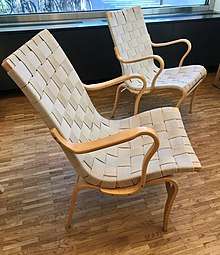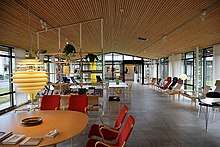Bruno Mathsson
Bruno Mathsson (January 13, 1907 – August 17, 1988) was a Swedish furniture designer and architect whose ideas aligned with functionalism, modernism, as well as old Swedish crafts tradition.[1]

Biography

Mathsson was raised in the town of Värnamo in the Småland region of Sweden, the son of a master cabinet maker.[2] After a short time of education in school, he started to work in his father's gallery. He soon found a great interest in furniture and especially chairs, their function and design. In the 1920s and 30s he developed a techniques for building bentwood chairs with hemp webbing. The first model, called the Grasshopper, was used at Värnamo Hospital in 1931.[3]
Edgar Kaufmann Jr., director of the Industrial Design Department at the Museum of Modern Art (MOMA), collected Mathsson's chairs and included them in several exhibitions in the 1940s.[4] Kaufmann considered Mathsson's importance in furniture design on par with that of Alvar Aalto.[5] Kaufmann and his family also had a Mathsson chair at their house Fallingwater.[6]
Mathsson was also an accomplished architect; he completed about 100 structures in the 1940s and 50s.[7] He was the first architect in Sweden to build all-glass structures with heated floors. His furniture showroom in Värnamo (1950) was a significant example; it is well-preserved and open to the public today. For his glass houses, he developed double- and triple-pane insulated glass units called "Bruno-Pane".[8]
He traveled extensively in the United States and was strongly influenced by the solar houses of George Fred Keck. Mathsson's architecture was also influenced by a visit to the Eames House by Charles and Ray Eames in March 1949 just as it was being completed.[1]
Works

Furniture
- Grasshopper (1931)
- Mimat (1932)
- Pernilla (1934)
- The Eva Chair (1935)
- Folding table (1935)
- Paris Daybed (1937)
- Swivel chair (1939-1940)
- Pernilla Lounge
- Jetson Chair
- Super-Ellipse™ table series, with Piet Hein (1966)
- Annika nesting tables (1968)
Architecture


- Bruno Mathsson furniture showroom, Värnamo (1950)
- house at Danderyd (1955)
- Villa Prenker, Kungsör (1955)
- Kosta Glassworks exhibition hall and residences, Kosta (1956)
- weekend cottage at Frösakull (1960)
- "one of the most daring examples of his glass houses."[3]
- Södrakull, outside Värnamo (1965)[9]
References
- Widman, Dag; Winter, Karin; Stritzler-Levine, Nina (2006). Bruno Mathsson: architect and designer. New Haven and London: Yale University Press. ISBN 9780300121919.
- "About Bruno Mathsson". Bruno Mathsson International AB.
- "Bruno Mathsson: Architect and Designer, Past Exhibition, March 22 – June 10, 2007". Bard Graduate Center.
- "Bruno Mathsson". Museum of Modern Art.
- Kaufmann Jr., Edgar (1947). "Modern rooms of the last fifty years" (PDF). Museum of Modern Art.
- https://fallingwater.org/history/preservationcollections/collection-highlights/
- Christiansson, Carl E. (1966). "Bruno Mathsson: Furniture/Structures/Ideas". Design Quarterly. 65: 1–2, 5–31. JSTOR 4047313.
- Kiss, Bernadett; Neij, Lena (2011). "The importance of learning when supporting emergent technologies for energy efficiency: A case study on policy intervention for learning for the development of energy efficient windows in Sweden". Energy Policy. 39: 6514–6524. doi:10.1016/j.enpol.2011.07.053.
- Xie, Jenny (December 5, 2017). "Swedish Designer Bruno Mathsson's Home Is a Perfect Midcentury Time Capsule". Dwell magazine.